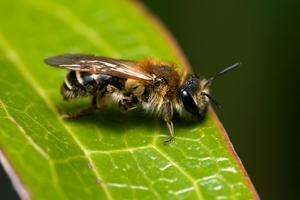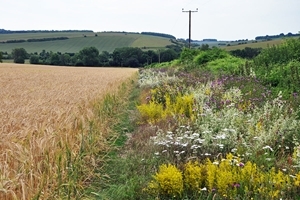Key points
- Pollinators are critical for agriculture, but are declining along with other farmland wildlife.
- This study looks at how good different Environmental Focus Areas are for supporting pollinators, involving experts from 18 different countries.
- There is wide variation in how well different EFAs are thought to support pollinators, both across Europe and throughout the year.
- No single EFA habitat provided well for all pollinators, and floral food was scarce late in the season.
- The habitat provided for pollinators by EFAs could be greatly improved, as could their management.
- Pollinator friendly management needs to be more widely implemented and habitats better connected.
Background
 Farmland biodiversity in general has declined since the 1950s, with a particular loss of habitat within and around crops. Biodiversity in the farmed environment underpins many important wider processes than agriculture alone, for example nutrient cycling, pollination of both wild and farmed plants, and natural pest control.
Farmland biodiversity in general has declined since the 1950s, with a particular loss of habitat within and around crops. Biodiversity in the farmed environment underpins many important wider processes than agriculture alone, for example nutrient cycling, pollination of both wild and farmed plants, and natural pest control.
The European Union’s Common Agricultural Policy (CAP) introduced compulsory Environmental Focus Areas to combat the loss of biodiversity by providing financial support for more environmentally friendly farming. These EFAs can be hedges, areas of woodland, ditches and ponds, buffer strips, field margins – all areas that provide variety in the farmed landscape and may support wildlife.
This study looked at how well EFAs can support pollinators. Although pollinators can and do forage in crops when they are in flower, this is usually for a short period of the year, so pollinators also need a steady source of food when the crops are not flowering. This needs to come from the surrounding semi-natural habitats and EFAs. EFAs can complement the crops in this way, providing vital food and shelter for pollinators if they are well managed and plentiful enough.
What they did
This study examines three important components which can affect how well EFAs can support pollinators.
- Their inherent potential
- Which species are present, and the resources they could possibly provide
- Their management
- This can either allow the area to fulfil its inherent potential as described above or limit it, if the management constrains its quality
- Their uptake
- If an option is not taken up and applied, it cannot fulfil its possible role
Through a defined process of co-operation of anonymous discussion, a consensus expert opinion was agreed upon. An initial workshop was held, followed by a wide-ranging literature review, then 22 experts from 18 countries across Europe worked to achieve a two-thirds consensus on scoring the different EFA habitats. This included extensive discussion of the supporting evidence to score each habitat between 0 and 3 for its potential to support insects under either standard, or pollinator-friendly management for each of the following categories:
- Floral food
- Early season
- Mid-season
- Late season
- Open flowers
- Tubular flowers
- Bee-nesting sites
- Hoverfly larvae
- Those that eat insects
- Those that eat dead matter
The different EFAs were analysed for their ability to offer the three main resource types, for both management options, in the three main regions of Europe.
What they found
 The study found that how well different EFAs provide food and shelter for insects is very variable. Different kinds of feature can support insects at different times of year, and this varies across Europe.
The study found that how well different EFAs provide food and shelter for insects is very variable. Different kinds of feature can support insects at different times of year, and this varies across Europe.
The benefits that EFAs can give to insects is also heavily affected by how they are managed. Each kind of habitat was assessed as to how it could provide for insects both under ‘standard’ or ‘pollinator-friendly’ management. The latter included approaches such as: using nitrogen fixing and woody plants in forested areas as these can provide more floral resources for pollinators; encouraging a diverse mix of flowering plants; allowing these plants to flower, rather than cutting before flowering; lower pesticide use on EFAs to reduce the risk of exposure for pollinators; and making sure that bare ground and areas of dead wood are available for nesting sites. There are many small adjustments that can be made to improve the benefit of EFAs for pollinators, which are described in detail in the paper itself (Table S2).
Under standard management, no single EFA category scores well for all resources – i.e., they cannot provide food, offer safe nesting sites and support hoverflies. With this management, EFAs offer more limited benefits to insects in northern and western Europe than in the south and east. However, adopting pollinator-friendly management could remove these geographical effects, raising the benefits of EFAs in northern and western Europe to match those in the other areas.
Of the options available that can be counted as an EFA, many farmers choose those that will also play a role in their farming approach, such as leaving land fallow or planting nitrogen-fixing crops such as field beans. These areas then serve two purposes in satisfying the CAP criteria as an EFA, thus contributing to the 5% requirement, whilst also being low cost or being the nitrogen-fixing crop in a farming rotation.
However, although such EFA options are widely taken up, they fail to deliver the resources needed by pollinators, even if under pollinator-friendly management. Although a rich source of pollen when flowering, this flowering period is short, and nectar can be inaccessible to many species. The widespread use of pesticides on such crops also reduces their wildlife benefit. This pattern is seen across all regions studied.
Seasonal variation
Across Europe, the availability of food offered by EFAs in the form of pollen and nectar varied throughout the year. Hedges, trees and woodland were felt to be a rich source of food early in the year, continuing to the mid-season in some parts of Europe, but which drops away in the later season. Field margins can provide a good source of food at different times of year. In southern and eastern Europe, they were one of the highest scoring habitat types throughout the pollinator season, but they lack resources in the early season in northern and western Europe.
No EFA managed using standard techniques provided a good food source later in the season, particularly in northern and western Europe.
What does this mean?
This study shows how different EFAs vary across regions and through the year in their ability to provide food and shelter for pollinators.
It particularly highlights a lack of food in the later season, and that this may be improved in northern and western Europe by adopting simple pollinator-friendly management of these areas.
The detail this study reveals for EU countries on which EFAs can provide resources in their region and at what time of year will be invaluable when governments are designing their choice of EFA options.
Nesting sites for wild bees are mainly in semi-natural habitats, for example with bumblebees preferring tussocky grasses, often at woodland edges. Solitary bees nest either in the ground, or in cavities in vegetation or other structures (e.g. dry stone walls/terraces). Bees rarely nest in crops, so the current tendency towards certain crops as EFA options limit the availability of nest sites. Placement of habitats that provide nest sites such as woodland near to those that provide rich food resources will offer the best support for some species.
Overall, EFAs are largely failing to support pollinators well enough. There is a shortage of bee nesting sites, late-season food, and resources for hoverfly larvae. It is important to increase the diversity of habitats that are available, improve their quality through adjusting management, and ensure they are joined up across a landscape.
Read the original paper
Cole, LJ, Kleijn, D, Dicks, LV, et al. A critical analysis of the potential for EU Common Agricultural Policy measures to support wild pollinators on farmland. Journal of Applied Ecology. 2020; 00: 1-14.